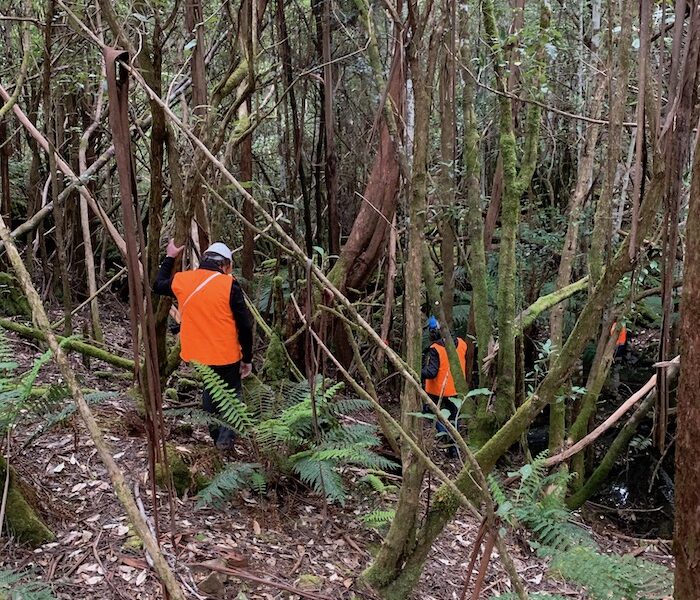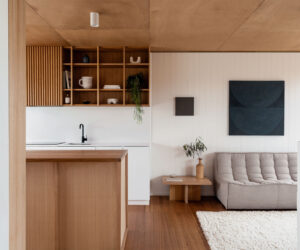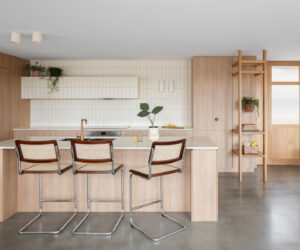Tasmanian Visiting Architects Program
Fitzpatrick + Partners, one of Australia’s leading architectural firms, travelled to Tasmania recently to experience firsthand Tasmania’s forest management practices and timber industry. The firm’s four Partners spent three days exploring Tasmania’s beautiful forests, learning about how they are managed, the Forest Practices System and sustainability certification. They also learned about Tasmanian timber processing and products, and the applications for those products in both residential and commercial settings.
The Program
After a welcome dinner on the first evening and a peaceful night at Moss Hotel, the Architects started their first full day at McKay Timber examining the mill and its extensive rage of timber products.
Day One
This was followed by a visit to the source to see the provenance of the timber. The architects explored a regrowth native forest in the Florentine Valley. The public forest manager, Sustainable Timber Tasmania, explained the intricacies of sustainable forest management while walking through the lush understory of the now regrown but previously harvested area.
That evening at Pumphouse Point, The Forest Practices Authority, explained the rigorous independent forest practices system that governs forest operations in Tasmania.
Day Two
On the second morning, the program showcased Hydrowood. One the world’s first underwater forestry operations, Hydrowood is harvested from a forest that was submerged 50 years ago beneath a man-made lake on Tasmania’s west coast that was created for hydro-electricity production.
The afternoon was spent at Britton Timbers in the far north-west to fully examine how timber is processed into a variety of products including veneer leaf. Here the architects also learned about the utilization of processing residues to heat the local swimming pool and power a nearby food processing factory as well as the mill itself.
The evening was spent learning about the applications for Tasmanian Timber at Freycinet Pavillions, with Expert Timber Helpline guru Michael Lee and Tasmanian Timber Ambassador Jon Goulder.
Day Three
On the final morning they visited the new Piermot Retreat development featuring Woodsmith engineered Tasmanian Oak Flooring.
We sat down with Partner Paul Reidy of Fitzpatrick + Partners, to find out some of his key learnings from the program and why he wanted to come.
Preconceived Notions Dispelled
No strangers to timber, Fitzpatrick + Partners have been long time champions of the material.
“Our primary reason for coming down was to become more sophisticated in our knowledge of timber – to understand how we can take the advantages of the material further in our designs so that we can grow the way we use the material,” says Paul.
“For us, timber is becoming almost a ubiquitous material. We’re looking at it structurally, we’re looking at it in linings, and when we contrast timber with other materials, with its sustainability properties and the way its utilized, it’s very important to our business,” says Paul.
Despite having a sound knowledge of timber, Reidy explains that the program dispelled myths about the industry.
“We’ve all walked away with preconceived notions dispelled and our knowledge level just gone through the roof.”
“Knowledge is power. So really that’s one of the biggest outcomes I think, of the last few days.”
‘We’ve also made a lot of great connections – connections into industry, into research. The [Visiting Architects Program] has opened up a lot of possibilities and opportunities that just simply weren’t there before.”
Sustainability, innovation and collaboration were the three key outtakes.
Sustainability, Durability and Wellness Bring Local Timber to the Fore
With sustainability a large focus for Fitzpatrick + Partners, Reidy explains it’s an integral part of the building process.
“Sustainability is something that we are all focused on. And that’s not just the health of the planet. Obviously, it’s that, but it’s a bit more than that as well. It’s how we live our lives and the degree to which we respond to different materials.”
“Wellness is becoming a very big thing and certainly a big focus in commercial work. What can the building do to help those inside it as well as the planet? That overlay brings timber to the fore. Everybody seems to have a very strong positive response to timber and timber buildings.
And the sustainability overlay brings timber to the fore as well.”
Reidy also explains that Timbers inherent durability allows timber to age with its owner and generations beyond.
“The other thing about timber that we really like is its capacity to age really well. It takes on a patina of use… it gets scuffed, it gets marked, it gets dented. But unlike other materials those things aren’t negatives to the product. They add to their character.”
Reidy says the locality of a product is also a key part of the sustainability message.
“One of the things that we hate a lot is air miles – the amounts of transport involved in the product that we use. Being able to source product locally is very important. For sustainability, everything that we do is going to have to become more and more local. And we want to support the local industry as well.”
Innovation ‘that’s Really Quite Astounding’
Continuously reviewing their processes, systems and best practices across the entire sector, the Tasmanian industry continue to innovate to ensure value is maximized and none of this precious material is wasted.
“The level at which the mills are innovating is not just in the product that they’re putting out the door, but how their whole cycle works. And that’s really quite astounding,” says Paul.
“Everybody’s investigating getting the highest recovery out of every tree. The sophistication in the veneering processes, the different flooring products, from solid wood down, there’s a real focus on using every last millimeter. Seeing that has been really informative.”
Collaboration: an Industry Working Together
The level of collaboration happening across the Tasmanian timber sector was also eye-opening for Paul. Paul explains how the entire sector is on the same page.
“We hadn’t expected that the various suppliers in the industry would be collaborating. There seems to be a lot of cross fertilization of ideas and people prepared to help each other out which is quite extraordinary.”
“The people that we’ve met over the last week from industry, government and policy, the independent watchdog, to the Minister himself – everybody’s on the same page. They’re, working together to solve whatever the problem might be.
There’s a collegiate atmosphere where competitors are open with each other about what their processes are and what they’re doing. It allows the sector to do an awful lot more.”
Continuing to Learn and Collaborate Beyond the Program
On the final night of the program the Architects met Mick Lee from the Centre for Sustainable Architecture with Wood, who answers the expert timber helpline.
“Saying it’s a hotline, you kind of think, Oh, I get on the phone and I’m put through to some ‘whoever’. But it’s actually Mick. Being able to pick up the phone and talk to Mick would be fascinating.
“We’re trying to innovate in a lot of spaces with structural timber, for example. We talked on the last night with Mick, and he’s experimenting with that as well. I suspect coming out of this, we’ll probably do a bit of collaborating with Mick both at a university level and on a hotline level.”
Sustainability, Innovation and Collaboration



